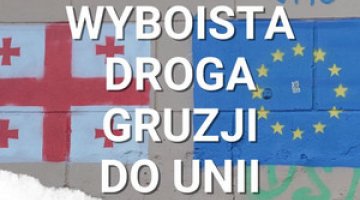Protests in Tbilisi should not threaten the government’s position
On May 21, protests demanding the resignation of President Mikheil Saakashvili started in Tbilisi. These have been the largest opposition protests in the last two years With the exception of a few incidents, they have passed off peacefully. The protests were organised by the National Assembly (NA) opposition movement, which is led by the former speaker of parliament (2001-2008), Nino Burjanadze.
After few days, the protests have lost their momentum. A brutal response from the authorities and possible bloodshed could be the only things which would intensify them again. This does not seem likely (the government’s reactions so far have been reserved), but it cannot be ruled out that tensions will rise on 26 May, in connection with the scheduled military parade on the occasion of Independence Day. Ms Burjanadze has announced that the NA will seek to stop the parade taking place, which is a signal that the protest organisers are about to risk a confrontation with the government.
If there is no sudden escalation, the protests will have no chance of influencing the political situation in the country in any significant way. The scale of the protests is limited, and the potential for mobilising the political forces behind them is relatively small. Despite the initial signals, the NA has not been joined by any other opposition forces. Although the current protests do not pose a threat to the governing camp, it should be noted that the level of public resentment is high, especially in the light of the protests’ social (and partly political) background. However, the opposition’s fragmentation, ineffectiveness and lack of credibility means that this resentment has no political representation.
The course of the protests
After a weeks of build-up, the protests began on 21 May in Tbilisi (and on a smaller scale in Batumi, although these petered out after the first day) and are still underway, with a variable, though clearly decreasing intensity. They were at their largest on the first day, when tens of thousands of people participated on Freedom Square. Next, the protesters moved to the television headquarters (between several dozen and several hundred people camped out there at night, and during the day the numbers rose to several thousands). Ms Burjanadze announced that their next objective would be to prevent the authorities from holding the annual military parade on the occasion of Independence Day.
The political force behind the protests is the group of people centred around Nino Burjanadze, who until June 2008 was a member of President Saakashvili’s team, and since then has become a radical critic of that team. Burjanadze is not a popular politician, among other things, because of her family links to the old nomenklatura; accusations of corruption; her meeting with the Russian government after the war of 2008, and suspicions that her movement has financing from Russia. Additionally, she is an isolated figure within the opposition. The current wave of protests sees Burjanadze putting everything on the line to ensure her return to politics and her position as a major opposition player on the political scene. It seems that in the absence of any real and sustainable public support; of any concrete programme; and of a long-term vision for her presence on the political scene, her only opportunity of achieving this aim is to work for an escalation of tension and the destabilisation of the internal situation. The success of such a scenario is unlikely.
The fact that such an unpopular politician has managed to organise the largest protests in two years testifies to Burjanadze’s ample financial and organisational resources, but above all, to the level of public frustration.
The political background
The Georgian political scene is dominated by President Mikheil Saakashvili and his party, the United National Movement (UNM). Although Georgia is by far the most advanced state regarding democratic reforms in the Southern Caucasus, the process is not complete. Its problems still include the full concentration of power in the hands of the President and his closest colleagues, the lack of an independent judiciary, the bias of the major government-linked television stations, the lack of equal media access for all political forces, the pervasive influence of the party and government structures, and the absence of a democratic political culture (in the forms of the government’s disregard for the opposition and the institutions of civil society, and its paternalistic treatment of the public).
These phenomena are causing social unrest, although as demonstrated in last year’s local elections (where the UNM received 65% support), most of the public sees no alternative among the opposition camp. The Georgian opposition is fragmented and conflicted, and in many cases has no agenda beyond its demands to remove Saakashvili from power. In addition, the ineffective mass protests of recent years (most recently in spring 2009) have discouraged a large proportion of the public from this form of political struggle. At the same time, next year's upcoming parliamentary elections and the continued high level of dissatisfaction will probably incline the opposition to make more attempts to mobilise the electorate.
Socio-economic issues
After the ‘rose revolution’ of 2003, the reforms introduced by President Saakashvili’s team led the Georgian economy to develop strongly in the years 2005-2008, at a growth rate of more than 8% of GDP per year. A rapid inflow of foreign direct investment (FDI) also began, which at its peak in 2007 amounted to more than US$2 billion a year. The world economic crisis and the war with Russia seriously slowed this trend (the FDI decreased to US$553 million in 2010, and GDP declined by 3.9% in 2009). At present, however, the Georgian economy seems to be returning to the path of expansion (GDP grew by 6.4% in 2010).
Nevertheless, Georgia’s economic development and the inflow of foreign investment has not significantly helped to solve the country’s pressing social problems, especially poverty and unemployment (which officially stands at around 13%, although unofficially it may be as high as 30%). The standard of living has been made even worse by high inflation (13.5% in April this year) and related significant increases in the prices of basic food products. This makes it likely that, although the development of the country since 2003 is obvious for and undisputed by most of the public, it has not given rise to a significant improvement in living conditions for large sections of society. This has caused great frustration (especially as inequalities have been rapidly increasing at the same time), which in the long term risks serious unrest. However, it seems that one condition for this would be the emergence of a credible political force, able to articulate social discontent at the political level.





